 In Italiano
In Italiano
The
particular one
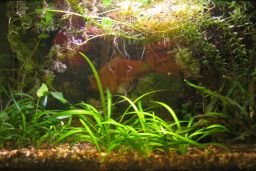 (click to
enlarge)
(click to
enlarge)
Fresh water, 20 litres, temperature 20-30
°C, pH neutral, nitrate 10 mg/l
There aren't fishes, only small
crustacean, bivalve, snails and plants.
Heater and temperature sensor are hidden
behind the half empty rock colon made sticking porous stones, large
holes among stones assure water circulation for convection, there isn't
a pump, it could devours smaller organisms.
There is an air pump regulated to the
minimum to move water.
A small amount of detritus is maintained in the bottom just like in
nature; in the rear glass I let to develop a substrate of alga very
appreciated by the inhabitants.
The difficult side of this kind of
aquarium is to maintain the right equilibrium among all life forms and
the small environment.
Food: fish food pulverised in a small mortar, pollen, boiled
vegetable and fruit.
It's always true the gold rule
of any aquarium: never exaggerate with food; a week without food will
not kill them, a single excess will do.
10% water change every three/four weeks with 24 hours rested home water
to let
chlorine to evaporate (just fill a 2 litres plastic bottle and leave it
open).
The inhabitants
The
inhabitants
(6 + x)
Neocaridinas
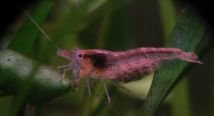 (female
20mm long with grey mature eggs)
(female
20mm long with grey mature eggs)  (small one
10mm long with a gold snail)
(small one
10mm long with a gold snail)


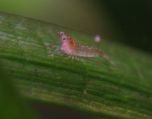
 (New
born
about 3mm long)
(New
born
about 3mm long)
 (male 19mm
long)
(male 19mm
long)
 (Top view)
(Top view)
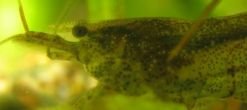 (The spots
have a stellar shape, 164 Kb)
(The spots
have a stellar shape, 164 Kb)
The female with grey mature eggs started to
release the new born
after 3 days from the
purchase, the small ones are 3mm long and quite similar to the adults.
Update: new born have grown to 5-6 mm in 4 weeks, the survival rate is
high,
I've count 8.
Update: at 6 weeks from birth they are 6-8 mm, I've count 12 grouping
them with
a piece of bread.
Update: a second female has black eggs, after two weeks they are dirty
white
with black eyes, the opening started after about three weeks, I've
count 7 new born but probably they are more; I'll have
too much of them
in few months.
Update: after 10 months from the introduction of the firsts 6 Neos the
population reached about 30-35 elements, the new born rate is quite low
now, the population is healthy.
Breeding easy.
Gammarids
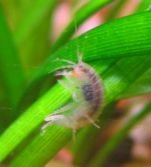 (Female with eggs, click to enlarge)
(Female with eggs, click to enlarge) 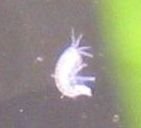 (New
born of about 2mm)
(New
born of about 2mm)
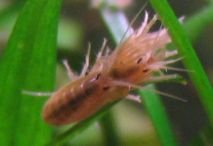 (Couple,
click to enlarge)
(Couple,
click to enlarge) 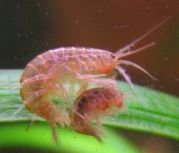 (Couple,
click to enlarge)
(Couple,
click to enlarge)
 (Attack to
the carrot, click to enlarge)
(Attack to
the carrot, click to enlarge)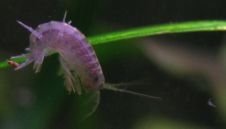 (Male with a
copepod on the right)
(Male with a
copepod on the right)
Crustacean
18mm
long for male, 15mm
for female, the new born are similar to the adult and are about 1.5mm
long.
Eggs,
from 5 to 15 below female abdomen, are black at the beginning and
yellow when mature.
It's
easy to distinguish sex, female are smaller and have eggs often; males
have front paws more robust and with a hook to clasp female.
Their position is arch like but they recline in a strait line when they
swim fast.
They damage partially plants but without ravage them.
They are omnivore, with a
vivacious character and social, typically they forms small groups.
It isn't a good sign if they start to be frenetic, another bad news is
the change of colour to white/yellow, a possible cause is the shortage
of oxygen or bacterium proliferation.
The first number reduction started after two weeks, after 6 weeks their
number is drastically reduced, at about two months I've count only six
of them; in the exoskeleton
of dead one I've noticed black spots.
Delicate, breeding difficult,
become extinct.
Bivalve
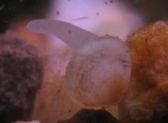 (With motion foot)
(With motion foot)  (It's about
3mm, click to enlarge)
(It's about
3mm, click to enlarge)
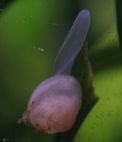 (Climbing the
glass)
(Climbing the
glass)
These bivalve,
large till 5mm, despite very slow they can climb.
They filters the water, so, it's necessary to keep the right density of
micro-organisms like bacterium, rotifers,
microalgae, etc. without exaggerate to avoid oxygen shortage due to bacterium;
the water must be limpid.
Breeding
difficult.
Copepods (Cyclops)
(click to enlarge)
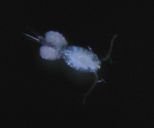
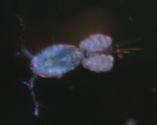

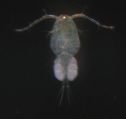
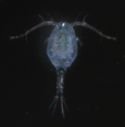
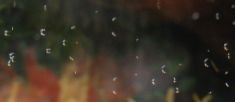
Crustacean 1mm long, on the back side you can see two groups of eggs.
From the images you understand why they are called cyclops, the have
only one reddish eye.
Breeding easy, in summer (28-30
°C) their number drastically falls but just below 25 °C it
increase again.
Ostracods



 (click to enlarge)
(click to enlarge)
Crustacean
0.5mm
- 1.5mm long enclosed in a couple of shells.
Breeding difficult but possible,
their number is low.
Long conic snails
 (click to enlarge)
(click to enlarge)  (click to
enlarge)
(click to
enlarge)
Maroon,
20mm long,
they excavate the bottom cleaning
and enriching it of
oxygen without create problems to the plants.
Breeding easy, their number is
stable.
Ellipsoidal
gold snails
 (click to enlarge)
(click to enlarge)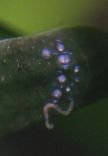 (Eight eggs
with a small worm)
(Eight eggs
with a small worm)  (Opening)
(Opening)
Maroon/gold,
6mm long,
inconceivably prolific.
Breeding very easy, their number
grow exponentially in an aquarium without fishes, I'm moving them in
the other aquarium.
Flat
spiral snails
 (click to
enlarge)
(click to
enlarge) 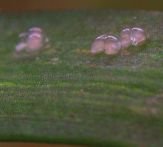 (click to
enlarge)
(click to
enlarge)
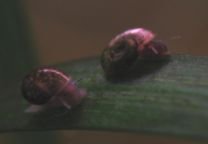 Overtake,
the
spiral wins, the
image is blurred due the impressive speed of the runners :-)
Overtake,
the
spiral wins, the
image is blurred due the impressive speed of the runners :-)
Maroon,
6mm long,
tranquil, they contribute to keep leaves clean.
Breeding easy, their number is
stably high.
Short conic snails

 (click to
enlarge)
(click to
enlarge)
Black,
4mm long, very slow.
Breeding difficult, their number
is low.
http://ausilio.altervista.org/
Copyright (C) 2004-2005, Rod @ ausilio.altervista.org

Updated on 6 January 2007
 (Female with eggs, click to enlarge)
(Female with eggs, click to enlarge)  (New
born of about 2mm)
(New
born of about 2mm) (Couple,
click to enlarge)
(Couple,
click to enlarge)  (Couple,
click to enlarge)
(Couple,
click to enlarge) (Attack to
the carrot, click to enlarge)
(Attack to
the carrot, click to enlarge) In Italiano
In Italiano (click to
enlarge)
(click to
enlarge) (female
20mm long with grey mature eggs)
(female
20mm long with grey mature eggs)  (small one
10mm long with a gold snail)
(small one
10mm long with a gold snail)


 (New
born
about 3mm long)
(New
born
about 3mm long) (male 19mm
long)
(male 19mm
long)
 (Top view)
(Top view)
 (The spots
have a stellar shape, 164 Kb)
(The spots
have a stellar shape, 164 Kb) (Female with eggs, click to enlarge)
(Female with eggs, click to enlarge)  (New
born of about 2mm)
(New
born of about 2mm) (Couple,
click to enlarge)
(Couple,
click to enlarge)  (Couple,
click to enlarge)
(Couple,
click to enlarge) (Attack to
the carrot, click to enlarge)
(Attack to
the carrot, click to enlarge) (Male with a
copepod on the right)
(Male with a
copepod on the right) (With motion foot)
(With motion foot)  (It's about
3mm, click to enlarge)
(It's about
3mm, click to enlarge) (Climbing the
glass)
(Climbing the
glass)








 (click to enlarge)
(click to enlarge) (click to enlarge)
(click to enlarge)  (click to
enlarge)
(click to
enlarge) (click to enlarge)
(click to enlarge) (Eight eggs
with a small worm)
(Eight eggs
with a small worm)  (Opening)
(Opening) (click to
enlarge)
(click to
enlarge)  (click to
enlarge)
(click to
enlarge) Overtake,
the
spiral wins, the
image is blurred due the impressive speed of the runners :-)
Overtake,
the
spiral wins, the
image is blurred due the impressive speed of the runners :-)
 (click to
enlarge)
(click to
enlarge)